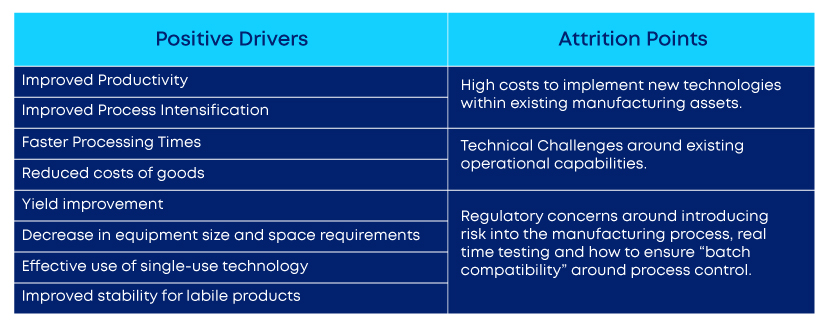Currently, the industry is facing a very high demand for biologics such as large proteins or vaccines. Because of that, bringing a Continuous Manufacturing (CM) process to these types of products, will improve their quality and deliver many business gains to your company.
So, with this blog post, we want to give you a little review about the topic of CM as well as some insights about its implementation. Are you ready for it?
Biologics and Their Challenges
As you know, biologics are large molecules and can be complex to produce.
This happens because they present a higher criticality at some levels such as:
- Manufacturing sciences and technologies
- Availability to patients
- Regulatory processes involved
Having all this considered, there’s still one thing to keep in mind: Continuous Manufacturing is the highest level of integrated design and processing currently available in biomanufacturing.
And because of that, there’s an added value in implementing technologies that enable CM.
But why Should you Move to Continuous Manufacturing?
Like we said at the beginning, the implementation of Continuous Manufacturing for biological products delivers gains to your company. Such as:
- Improvement in facility area reduction.
- Increase in upstream productivity.
- Reduction in downstream column size.
- Reduction of buffer usage.
In addition to these, CM requires smaller equipment and reduces the facility footprint, which results in facility cost savings.
When deciding to implement new technologies, like CM, you should do it must be based on the business, operational, risk and market strategies of your organization. And, of course, you should consider the impact of any facility assets in your decision-making process.
The Drivers That Shape Your Transition to Continuous Manufacturing
There are some key factors to consider when assessing the transition to CM:

As you can see, Continuous Manufacturing for biological products has a good number of positive drivers. But, like in any other change, it can meet some resistance.
When Should you Implement a Continuous Manufacturing Technology?
It’s not new that most of the manufacturing processes are developed in a batch-driven mode of operations. If moving to a CM process is something you are thinking about, there must be a plan including some questions that you need to answer:
- Is CM technically feasible?
- Business case: is it acceptable?
- Is the product risk acceptable?
- Are the processes risk acceptable?
- Is the control strategy acceptable?
- And what about the implementation strategy and the logistics control strategy? Are they acceptable?
And what happens if those answers are positive? What should you do? Well, in that case, we think that the CM implementation is a good fit for your processes!
But, if you’re still not convinced, we would like to say that starting a CM implementation will be a great opportunity to reduce the cost of goods. More than that, with it, you and your teams will be able to make products faster with lower capital costs, and less operator intervention.
We can Help Your Continuous Manufacturing Implementation
Our team is specialized in delivering Continuous Manufacturing Implementation and Support. If you’d like to move towards the benefits of Continuous Manufacturing, take a look at our services!


